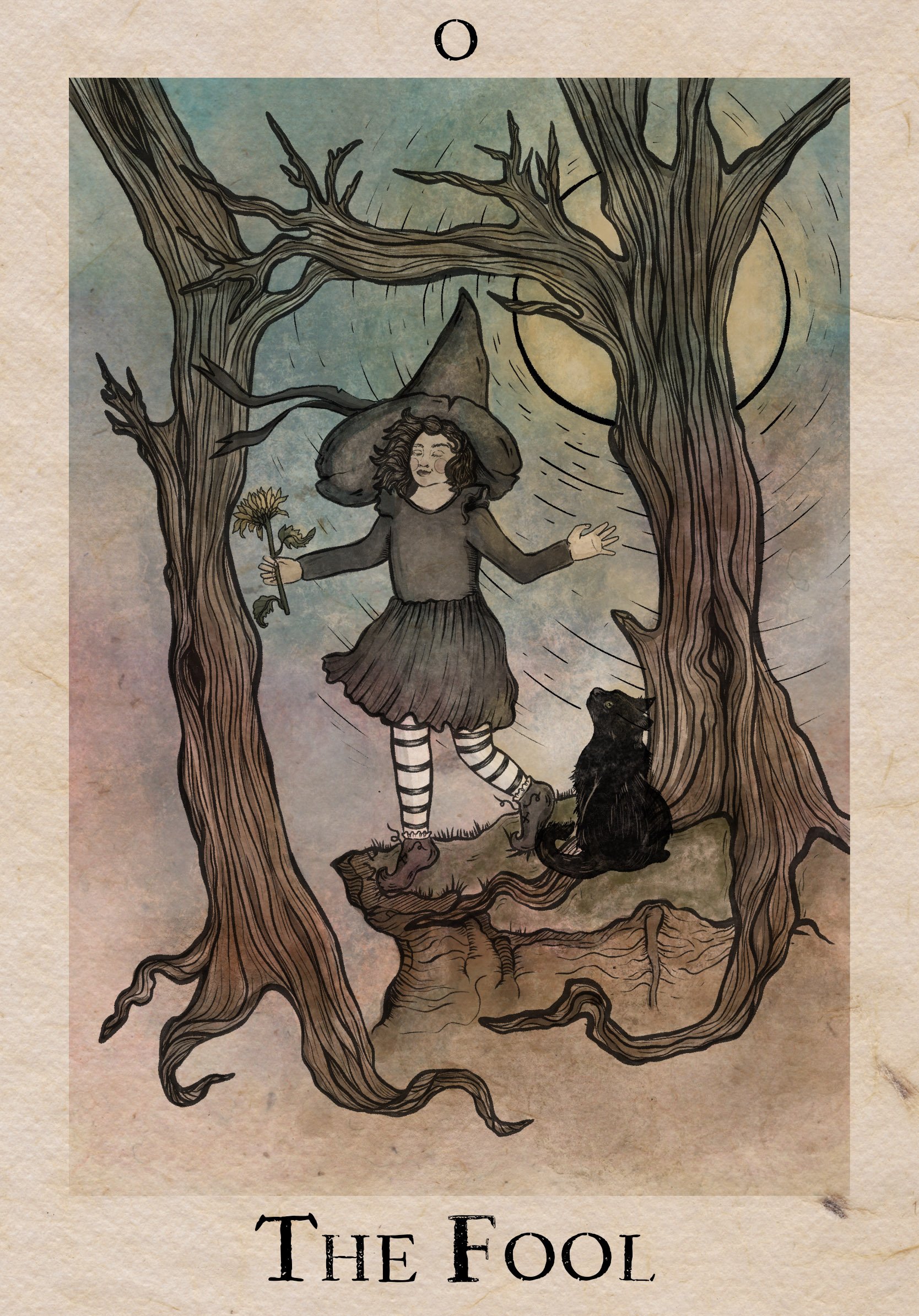
The Headless Maiden: A Little Witch Tale for the Harvest Moon
As luck would have it, spooky friends, we have a new Little Witch Tale live on the blog! Click here to read The Headless Maiden, an illustrated tale about harvesttime wishes, haunted hearts, and Ariadne, the heroine who lost her head.
September is a Spell: The Autumn Crossroads
Do you see any ghosts creeping around the garden? Which plants wave hello? How many colors are winding their way up your ankles, around your spine, and into your heart? Where are the crossroads carved into this next chapter?
Channeling Messages Beneath the Blue Moon
Once in a blue moon, we return home to the stories that made us. We cast a net into a golden tide of remembering, harvesting moon flowers and mystery from the succulent vines of nostalgia. Once in a blue moon, we're given opportunities to revisit the things we loved as children – our favorite books, creative companions, and the wistful seeds of yesteryear.
Lughnasadh Lessons: The Story of Lugh & Tailtiu
Serving as our midway point between Summer Solstice and the Autumn Equinox, Lughnasadh is a Celtic fire festival. Inspired by the grain mysteries, sacred partnerships, and the recently-ripened fruits of our labor, seasonal stories like the myth of Lugh and Tailtiu mirror these sentiments.
The Buck Moon: Artemis, Fairy Cattle, & the Magick of July
The Celtic god Lugh will soon be knocking at our doors, scythe in hand, sights set on our golden fields (look for Lughnasadh lore later this month!), but not until we've met July's moon and tasted her wild nectar, a blend of shapeshifting and untethered passions, a brew stirred by the one who wears the antlered crown.
Berries are Fairy Fruit: June Moon Folklore
In some parts of the Northern Hemisphere, June marked the start of berry season. Known as the Strawberry Moon, Blackberry Moon, Raspberry Moon, or Garden Moon, June's moon was dedicated to the berries ripening in the wild. Originally named by indigenous communities throughout Northern America and Canada, June is a welcome reminder that all things bloom in their own time.
Literary Spells: Spooky Spring Submissions
Calling all poets, storytellers, and literary witches - would you like to cast a spell with us? Hosted by Pointy Hat Press, the Spooky Spring Series was inspired by haunted hearts, spectral travelers, and confessional poetry.
Calling all Poets, Storytellers, & Literary Witches…
Is your journal brimming with springtime musings? Are there flowers scattered across the pages? Seeds embedded into the binding? Thorny tendrils leading you deeper into mystical, mysterious worlds?And (we’re all friends here, you can be honest), does it feel a bit spooky?
Floromancy for the Flower Moon: The Origin of the Rose
Sensual and chthonic, Witches and Goddess will cultivate this flower for spells of unfurling, blooming, and becoming. According to Roman myth, the goddess Venus adorned herself with scented rose petals and painted this flower's story, and the the pentagram, into the starry sky. In some tales, the Goddess of Love and Beauty is also credited as the mother of the rose.
Once upon a Beltane: The Tale of Syrinx & Pan
Beltane is the inverse of Samhain, so when the Hawthorn trees bloom, the veil to the Otherworld thins. The Hawthorne tree is said to be protected by Bloddeuwedd, the Welsh Goddess of Flowers and Initiations. Like the bee seeks out the most fragrant blooms, Hawthorn's blossoms attract abundance and authenticity, and Bloddeuwedd's berries speak to our ancestral roots. Legend says if we're able to gain the fairies' trust, Bloddeuwedd offers us a bouquet of protective thorns for as long as our Beltane fires glow.
Spooky Spring
Hosted by Pointy Hat Press, our Spooky Spring Series was inspired by haunted hearts, spectral travelers, and confessional poetry. To join in on the Spooky Spring challenge, submit an original poem, song, sonnet, short essay (500 words or less), or illustration about ghosts, ghouls, witches, or whatever haunted chambers you're exploring this spring.
Beneath the Pink Moon: Would you like to Cast a Spell with Us?
Spookiness is typically reserved for the dark half of the year, but who says the dead vanish when our gardens bloom? And who says haunted hearts cease to exist when the sun shines? When spring arrives, what happens to the ghosts of things left unsaid?
When All Fool’s Day Meets the Pink Moon
With so much to look forward to this April – burgeoning wildflowers, warmer days, the promise of a new season - why does a month of potential begin with All Fool's Day? Better known as April Fool's Day, the first of April has been dedicated to trickery and shenanigans for ages. In fact, while there are several theories as to how and when this tradition began, nobody can say for sure. Here are some interesting theories…
March Magick: The Worm Moon
While the name 'Worm Moon' feels fitting as we prepare for our garden spells, we might also know it as the Sugar or Sap Moon (a nod to the soon-to-be-tapped Maple trees) the Crow Moon (Delaware Native American origin), the Chaste Moon (Medieval origin), or my favorite, the Moon of Winds (Celtic origin).
The Snow Moon: An Imbolc Invitation
Also known as Brighid's day, Imbolc doesn't suggest we throw caution to the wind and ignore the lessons from winter. Because until the Springtime Heroine shows up in March (the Spring Equinox), the Winter Witch still steers the seasonal wheel. Like a light at the end of the tunnel, Imbolc is a spark. An awakening. It's an invitation to follow the flickering candle to the next chapter of our story.
January is for the wolves…
In Dreamland, we adventure to our heart's desire, collect seed-shaped stories, and upon rousing from our beds, we scatter them throughout the waking world. It would appear that after many years of planting fairy tales in our gardens, within our hearts, and between the pages of our favorite books, these stories' ancient roots continue to twist and weave between worlds.
The Moon Before Yule
December's moon is known as the Cold Moon, Long Night's Moon, and the Moon Before Yule. Traditionally, the final moon of the year was an invitation to reflect on our struggles and successes, and where we'd like to be in the coming months. In magickal circles, some people use this time to rest and recharge, while others utilize the extra moonlight for lunar magick. Spells related to dreamwork, journeying, and psychic forecasting are popular during the long nights – no matter the moon's phase.
Apple Magick: The Fruit of the Underworld
When thinking about enchanted orchards as they appear in fairy tales and folk stories, there are none as famous as the mystical, magical apple. Governed by Venus and said to be the fruit of the gods, apples ripen en masse as the dark months arrive and we invite fire back into our homes. Apples are also known as the food of the dead and the fruit of the Underworld. At one time, Samhain was called the Feast of Apples.
Once upon a November Moon…
Traditionally, November's moon is nicknamed after the hardworking, crafty, semi-aquatic creature – the beaver. Like other warm-blooded animals, the beaver is busy preparing his winter den. He won't burrow into the earth like his good friends the hedgehog and chipmunk, but will create a cozy, above-ground lodge with sticks, mud, and leaves. The beaver doesn't hibernate, but he still needs to keep warm and dry during the cold months.
A Samhain Invitation
Enchanted meals have been ritualized for centuries, but with Pagan and ancestral folk practices finding their way back into the light, this year more than ever we've heard people discussing one of our favorite rituals – hosting a Dumb Supper.






















